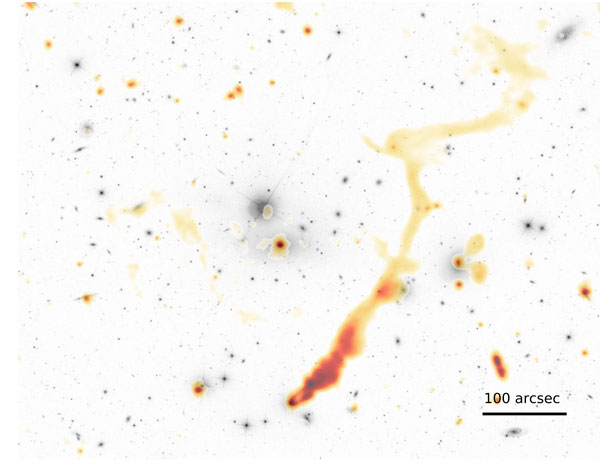The LOFAR survey, based in The Netherlands, has released a bonanza of new sources. And with only 2% of the sky covered so far, this is only the beginning.
A unique sky survey at low radio frequencies has turned up more than 300,000 new sources, many of which are radio galaxies and quasars in the distant universe. And there’s much more to come: The new discoveries, published in a special issue of Astronomy & Astrophysics, are based on just 2% of the eventual survey volume.

Rafaël Mostert / LOFAR Surveys Team / Sloan Digital Sky Survey DR13
“For the first time, we now have high-quality images of the radio sky at these low frequencies,” says Huub Röttgering (Leiden University, The Netherlands), principal investigator of the LOFAR Surveys Key Science Project. “That’s the real breakthrough.”
The Low Frequency Array (LOFAR), operated by ASTRON, Netherlands Institute for Radio Astronomy, is a novel instrument, consisting of some 100,000 simple antennas, grouped in 50 stations and connected to a central supercomputer through fiber optics. Most of the LOFAR stations are located in the Netherlands, but 12 of them are spread all over Europe, from Ireland to Poland and from Sweden to France.
Eventually, the Low-frequency Two-meter Sky Survey (LoTSS) will map the whole northern sky, but the first data release covers just 424 square degrees, centered on the handle of the Big Dipper. A total of 58 “radio pointings,” each 8 hours long, have been carried out at frequencies between 120 and 168 megahertz, yielding enough data to fill 10 million DVDs.
According to Röttgering, the biggest problem has been removing the effects of ionospheric turbulence, the radio equivalent of stars twinkling at visible wavelengths. Through clever mathematical tricks, scientists have sharpened the data to see details 6 arcseconds across.
The new catalog has 325,694 radio sources, accompanied by 58 high-resolution mosaic radio images. For about 70% of the sources, visible-light counterparts were found in existing data from the Sloan and Pan-STARRS surveys, giving astronomers rough distance estimates to the objects.
The radio waves from the galaxies that LOFAR has found are primarily generated by electrons spiraling along magnetic field lines that thread jets coming from the galaxies’ central black holes. Once these electrons have been spiraling for a while, they slow down and emit lower-frequency radio waves, so LOFAR is seeing jet activity on much longer timescales than existing higher-frequency radio surveys.

ASTRON
One intriguing result is that all relatively massive galaxies exhibit jet activity close to their cores, which suggests that their central black holes are feeding more or less continuously. The new observations should shed light on the evolution of supermassive black holes over cosmic time. “Eventually, we hope to find the very first supermassive black holes in the history of the universe,” says Röttgering.
The 26 papers in Astronomy & Astrophysics, authored by more than 200 scientists from 18 countries, also cover LOFAR data on galaxy clusters. According to Annalisa Bonafede (University of Bologna, Italy), one surprising result is that even isolated clusters that aren’t interacting with their neighbors still produce radio emission from charged particles speeding among the gas between galaxies, though the emissions are at a very low level.
The future Square Kilometre Array (SKA) has a low-frequency segment based in Australia, which will be even more sensitive than LOFAR, but it won’t see details as sharply. According to Röttgering, LOFAR’s high spatial resolution (it may discern details up to 0.5 arcseconds across under ideal circumstances) will be unsurpassed for a long time to come.
 4
4









Comments
Klarn Mxyzptlk
February 22, 2019 at 4:50 pm
"If you can imagine it, it is true." -- Albert OneStone
You must be logged in to post a comment.
Anthony Barreiro
February 25, 2019 at 7:46 pm
Thanks for this interesting report.
How does cosmological redshift affect radio observations? By the time they get to us, these photons from the early universe are travelling at radio wavelengths. What were their wavelengths when they were first emitted billions of years ago? (I'm used to thinking in terms of wavelength. I suppose I should use the radio convention and rephrase the question in terms of frequency.)
You must be logged in to post a comment.
Monica Young
February 26, 2019 at 11:21 am
Great question! Govert says: LOFAR does look for redshifted 21-cm radiation from neutral hydrogen in the very early universe. But the instrument is sensitive to a broad range of wavelengths. For the radio galaxies mentioned in this story, LOFAR detected their synchrotron radiation, which is emitted at low frequencies. When looking at high-redshift sources, though, we're seeing the higher-frequency end of this emission. In most cases, the redshifts are smaller than a factor of 3.
The paper on the (photometric) redshift estimates of the LOFAR survey sources can be found here: https://arxiv.org/pdf/1811.07928.pdf
You must be logged in to post a comment.
Anthony Barreiro
February 26, 2019 at 3:16 pm
Thank you Monica and Govert. I appreciate having a ballpark figure for the redshifts of these objects. Duncan et al.'s paper is mostly over my head, but I'll try to puzzle through as much of it as I can.
You must be logged in to post a comment.
You must be logged in to post a comment.